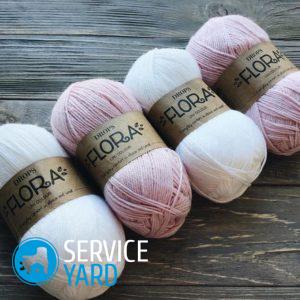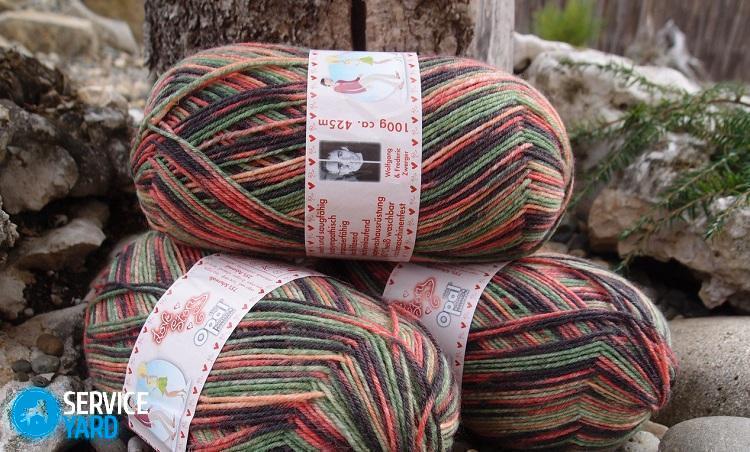Yarn for socks - which is better?

Winter comes, it gets cold. At such a time, you dream about a mug of hot tea, a warm blanket and warm woolen socks knitted by a grandmother. Socks are knitted not only by grandmothers, you yourself can knit them - there is nothing particularly complicated. But first you need to buy yarn, knitting needles, and then you can already begin this mysterious process of turning ordinary threads into warm and cozy things. But the question is: yarn for socks - which is better? Let's talk about all the knitting tricks.
to contents ↑Thread for socks
What yarn is better to knit socks and how many threads do you need?
- Such products are often washed, they are subjected to maximum load, therefore, the threads for them should be durable and not capricious in the wash. Many people think that since the socks should be warm, then the ideal option is pure wool. But it turns out this is not so. Such things will quickly wear off from frequent washes, especially in the heel area.
- Threads for knitting socks should be soft and pleasant to the touch. From coarse fiber will turn out products that will be unpleasant to wear.
For warm socks
How to choose threads for children? What kind of threads is better to knit warm baby socks? Good threads for warm socks consist of a mixture of wool and man-made fibers. The most popular among synthetic threads is polyamide. Sometimes cotton is added to the main raw materials.
Important! Synthetic fibers will make the threads more durable. Products from such yarn tolerate washing well in an automatic machine at a temperature of 40 degrees in a delicate mode. After such washing, they do not roll and do not fall off.
Heel and toe are best knitted from acrylic threads, they are more durable and will not be quickly wiped. For example, for knitting winter socks, the Schachenmayr Regia variant is perfect, which includes 75% sheared wool that can be washed, and 25% polyamide.
For light socks
For light spring socks with delicate patterns, you can use cotton yarn reinforced with the same polyamide.
to contents ↑Important! Experienced needlewomen do not recommend knitting with bamboo threads, as they are very stretched and deformed during washing.
Color selection
Of course, you can choose the threads by color yourself. If in Soviet times, threads were exclusively gray, brown or blue, then now on the shelves of shops you will find yarn of various shades and colors. But there is a basic rule when knitting socks: the simpler the pattern, the brighter the colors should be.
to contents ↑Important! If you knit a sock with a stitch, then you can paint it with multi-colored stripes. On a complex relief pattern, such a combination of colors will not look.
Choose knitting needles
Socks are knitted with stocking needles in a circle. Five short knitting needles are included in the package. For socks, products of 2-3 sizes with a length of 15-20 cm are suitable.
The thickness of the main tool depends on the following factors:
- From the thickness of the threads.
- From the thickness of the knitting: if you need tight knitting, take thick knitting needles, if more loose - thinner.
to contents ↑Important! In addition, such tools are matte or shiny. Here it’s more convenient for anyone. There are also bamboo knitting needles on sale that are also very comfortable to use.
Additional tools
Some experienced craftswomen cost only knitting needles and threads. But when knitting socks, it is convenient for beginners to use the following tools:
- Optional double-pointed knitting needle for hinges. It can be replaced with a safety pin.
- Small tips will help you if the loops slide off the knitting needles all the time - just fix them on the ends of the knitting needles.
- To make it easier to navigate in the patterns, the ends of the rows can be marked with a ring marker made of plastic.
- The knitting of complex patterns will be facilitated by auxiliary knitting needles with a curly middle part.
- To prevent tangles, use a special thimble that has several grooves.
- Scissors choose as sharply as possible. Dumb ones will not cut the yarn, but will crumple it and pull the fibers out of it.
Stock footage
Now you can go to the store for suitable materials in order to prepare warm clothes for the winter, in which it will be both comfortable and warm.
- How to choose a vacuum cleaner taking into account the characteristics of the house and coatings?
- What to look for when choosing a water delivery
- How to quickly create comfort at home - tips for housewives
- How to choose the perfect TV - useful tips
- What to look for when choosing blinds
- What should be running shoes?
- What useful things can you buy in a hardware store
- Iphone 11 pro max review
- Than iPhone is better than Android smartphones




